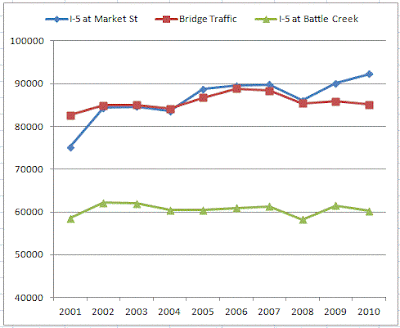Would it kill the paper just to print a graph of the actual numbers? Doesn't have to be any explanation, even. Just let people decide for themselves whether bridge traffic is increasing, flat, or declining, and whether any shift started before or after the recession?
But the framing in the piece on this is easily questioned - more can be done than "he said, she said":
When the recession hit in 2008, a slowdown in construction might have been at least partially responsible for decreases in traffic over the Marion and Center street bridges, said Mike Jaffe, a planner with the Mid-Willamette Council of Governments. Some bridge planning opponents cite that flat line as an indicator that an additional crossing is not necessary.Here's data from the Federal Reserve, that bastion of goofy, alternative lifestyles:
 |
| Driving and Recessions - Matthew Yglesias at Slate |
 |
| OSPIRG chart shows multiple scenarios |
No Third Bridge has charts with data from 2011 (and maybe even brand new data from 2012) - but the outlines are not different: The most optimistic projection shows the bridge traffic is flat and participates in the plateau and tentative decline we see in the two national charts above. (The outlier of the Market St. Interchange deserves a closer look, but it appears to be an exception, not the rule.)
 |
| An old chart looking at highway traffic |
Anyway, it's not surprising the debate is prolonged because in addition to its enormous cost, the bridge question really gets at fundamental issues of lifestyle, choice, freedom, and the future of Salem. It's a distillation of core matters.
In the story staff are quoted:
City manager Linda Norris said recently that construction of another area bridge over the Willamette River, something transportation planners stress is necessary to keep up with growth, likely wouldn't get traction for another 10 to 15 years....And a commenter piles on:
Some of the SRC hinges on decisions made decades ago, Fernandez said, when planners aimed at preserving fertile farmlands east of Salem and set growth sights west. The largest chunk of Salem’s developable land within its Urban Growth Boundary is west of the Willamette.
For those who are opposed to the third bridge idea. let me remind you of one inescapable certain-as-the-tide fact: The city of Salem is growing, as is West Salem. The infrastructure needs to grow along with it, or it will be overwhelmed. To oppose any kind of expansion of infrastructure to meet the demand brought about by the growth is short-sighted and counterproductive.It's good to see at least some of the rhetoric focused on Salem. Truly, this is more about the future of Salem than about solving some supposed regional traffic problem. That regional traffic talk is often a distraction, sometimes even subterfuge.
In so many ways the nub of the matter is this: Salem doesn't have to devote enormous public resources to subsidizing low-density sprawl in West Salem. Building a giant bridge and highway to support low-density growth there is a policy choice and a funding choice. It's not inevitable. It's not "certain as the tide." (And why those who build this new development should be able to saddle others with the cost?) It's something that we will make happen by deliberate action and funding choices, and not something we merely passively observe.
Equally, we can choose not to spend $800 million on a giant bridge and highway, we can still choose not to develop "fertile farmlands east of Salem," and instead can "set our growth sights" on medium- and higher-density development nearer to downtown and in investing better in the neighborhoods that would have been hurt by the proposed giant bridge and highway.
(And this, by the way, will get more customers close to downtown and help make downtown healthy!)
Do we want a more compact city with a lively downtown? Or do we want more sprawl on the edges of the city, the strip mall and larger mall shopping environments this kind of development entails, and a downtown that continues to struggle?
This is a genuine choice Salemites face.
So it's not surprising this debate should drag out in frustrating, even infuriating ways.
For more on the River Crossing / Third Bridge see a summary critique and all breakfast blog notes tagged River Crossing. The No Third Bridge advocates also have lots of useful information. Next up is the continuation of the Public Hearing at Salem City Council on June 24th. Written comments are still being accepted. You can find your individual Councilor here or you can email the whole Council here.



1 comment:
Absolutely right on! Thank you "Breakfast on Bikes". Now City Council will you please listen to the citizens of Salem and engage in a thoughtful discussion of all the issues raised in this post and then tell us again why you think we must have a 3rd bridge.
Post a Comment